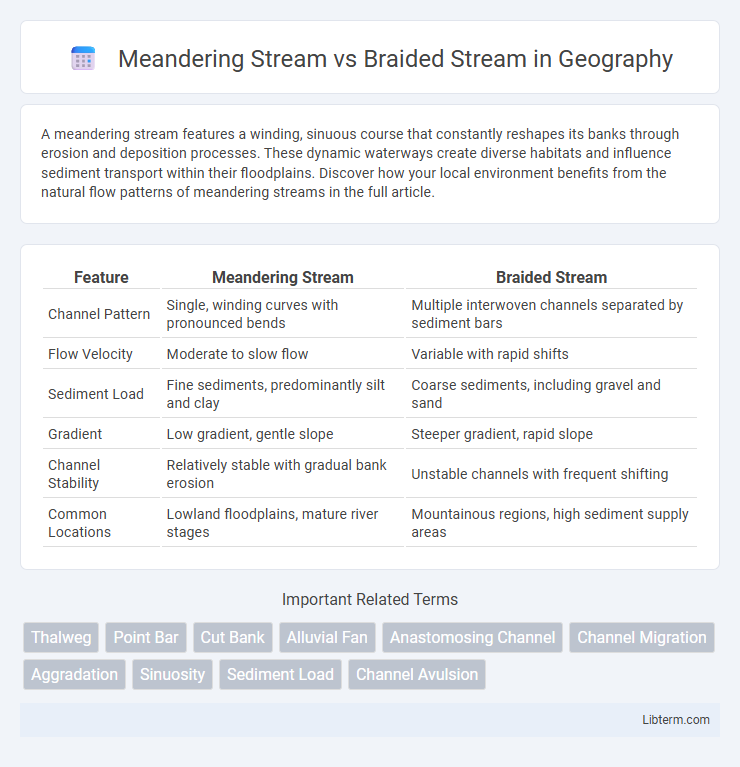A meandering stream features a winding, sinuous course that constantly reshapes its banks through erosion and deposition processes. These dynamic waterways create diverse habitats and influence sediment transport within their floodplains. Discover how your local environment benefits from the natural flow patterns of meandering streams in the full article.
Table of Comparison
| Feature | Meandering Stream | Braided Stream |
|---|---|---|
| Channel Pattern | Single, winding curves with pronounced bends | Multiple interwoven channels separated by sediment bars |
| Flow Velocity | Moderate to slow flow | Variable with rapid shifts |
| Sediment Load | Fine sediments, predominantly silt and clay | Coarse sediments, including gravel and sand |
| Gradient | Low gradient, gentle slope | Steeper gradient, rapid slope |
| Channel Stability | Relatively stable with gradual bank erosion | Unstable channels with frequent shifting |
| Common Locations | Lowland floodplains, mature river stages | Mountainous regions, high sediment supply areas |
Introduction to Stream Types
Meandering streams feature a single, winding channel that curves across floodplains, promoting sediment deposition on inner bends and erosion on outer banks. Braided streams consist of multiple interwoven channels separated by transient sediment bars, commonly occurring in areas with high sediment load and variable water flow. These stream types reflect differing hydrological dynamics and sediment transport processes essential for understanding fluvial geomorphology.
Defining Meandering Streams
Meandering streams are characterized by their winding, sinuous channel patterns that develop as water erodes the outer banks and deposits sediment on the inner banks of bends. These streams typically form in low-gradient areas with fine sediment, creating distinct point bars and cut banks that influence habitat diversity and channel stability. In contrast, braided streams consist of multiple interconnected channels separated by transient sediment bars, usually found in high-gradient, sediment-rich environments.
Characteristics of Braided Streams
Braided streams are characterized by multiple interweaving channels separated by unstable, sediment-rich bars and islands, often forming in areas with high sediment supply and variable water discharge. These streams exhibit steep gradients, coarse sediment load, and easily erodible banks, resulting in frequent channel migration and reorganization. Unlike meandering streams, braided streams have wider, shallower channels with less defined banks and a more complex network of flow paths.
Formation Processes of Meandering Streams
Meandering streams form through the process of erosion and deposition along gently sloping valleys, where water flow causes lateral erosion on the outer banks and sediment deposition on the inner banks, creating sinuous curves. This dynamic interaction results in point bars and cut banks, continually reshaping the channel over time. The balance of sediment load, flow velocity, and bank composition are key factors that influence the development and migration of meanders.
Formation Processes of Braided Streams
Braided streams form in areas with high sediment supply, steep gradients, and variable water flow, causing sediment to accumulate in multiple channels that frequently split and rejoin. Sediment deposition creates bars and islands, which divert flow and increase channel complexity. These processes contrast with meandering streams, which develop sinuous channels primarily through lateral erosion and deposition along stable banks.
Key Differences Between Meandering and Braided Streams
Meandering streams feature a single, sinuous channel characterized by smooth, sweeping bends and point bars formed from lateral erosion and deposition processes. Braided streams consist of multiple interwoven channels separated by transient bars and islands, resulting from high sediment load and variable discharge. Key differences include channel pattern complexity, sediment transport mechanisms, and bank stability, with meandering streams favoring cohesive banks and braided systems dominated by non-cohesive sediment.
Environmental Factors Influencing Stream Patterns
Meandering streams develop in environments with gentle slopes, fine sediment, and stable vegetation, which promote lateral erosion and sinuosity. Braided streams form in areas with high sediment loads, steep gradients, and variable water flow, causing multiple shifting channels around sediment bars. Floodplain vegetation, sediment supply, and hydrological variability critically influence the formation and maintenance of these distinct fluvial patterns.
Sediment Transport in Meandering vs Braided Streams
Meandering streams typically transport finer sediments such as silts and clays due to their slower flow velocity and well-defined single channel, promoting sediment deposition on point bars and erosion on outer bends. Braided streams carry coarser sediments like gravels and sands because of their higher flow energy and multiple shifting channels, which constantly erode and deposit sediments across the braid bars. The sediment transport in meandering streams is more selective and sorted, while braided streams exhibit a more heterogeneous sediment distribution caused by frequent channel rearrangements.
Ecological Impacts of Stream Types
Meandering streams create diverse aquatic habitats through slow flow and sediment deposition, supporting rich biodiversity and stable riparian zones. Braided streams, with multiple shifting channels and coarse sediments, often result in unstable habitats but promote dynamic nutrient cycling and pioneer species colonization. These contrasting stream types influence ecological resilience and habitat complexity differently, shaping ecosystems downstream and affecting species distribution.
Real-World Examples and Case Studies
Meandering streams, characterized by their sinuous curves and single, deep channels, are exemplified by the Mississippi River in the United States, where sediment deposition and erosion create distinct riverbanks and floodplains. Braided streams, featuring multiple interweaving channels separated by sediment bars, are well represented by the Brahmaputra River in India and Bangladesh, where high sediment load and variable discharge contribute to channel shifting and complexity. Case studies of these rivers reveal how sediment transport, flow variability, and valley gradient influence the formation and dynamics of meandering versus braided stream patterns.
Meandering Stream Infographic

 libterm.com
libterm.com